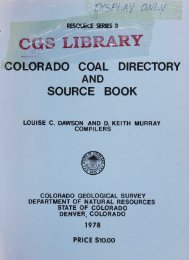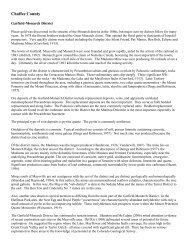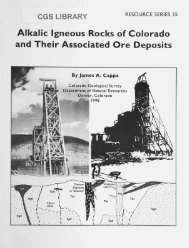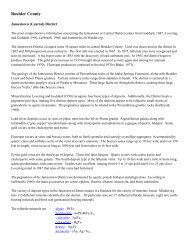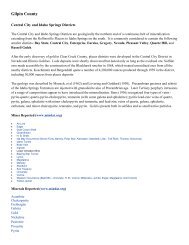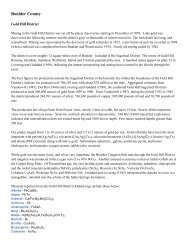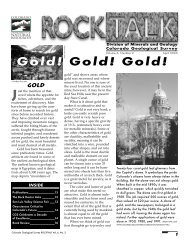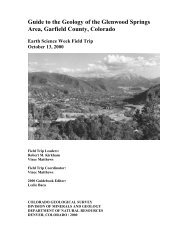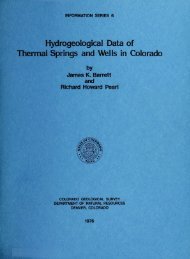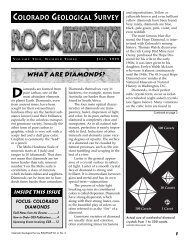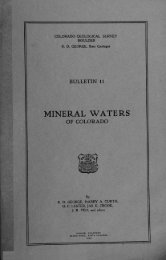Marble - Colorado Geological Survey
Marble - Colorado Geological Survey
Marble - Colorado Geological Survey
You also want an ePaper? Increase the reach of your titles
YUMPU automatically turns print PDFs into web optimized ePapers that Google loves.
at or near the upper existing quarry face which<br />
is close to the upper contact of the gray marble<br />
and at its northern most outcrop. The minable<br />
reserve here is limited by the steepness of the<br />
topography and the inclusion of chert layers in<br />
the lower portions of the unit. The volume of<br />
this Phase 1 surface minable prism is 3,260,000<br />
cubic feet. This is approximately 285,000 tons<br />
at the assumed 175 pounds per cubic foot. The<br />
Phase 2 operation here would be underground<br />
to access the remaining two million tons of gray<br />
marble. The southern area of the property is<br />
composed of white marble outcropping in rugged<br />
terrain. This area will require extensive<br />
development prior to mining and will require<br />
that all mining be underground. The development<br />
there would include site preparation of a<br />
service area, road building of 3,000 feet to the<br />
main haulage road, and stripping to an adequate<br />
area for an entry. In that area hornfels<br />
units which overlie the marble are extremely<br />
folded and would form an irregular back which<br />
would be difficult to maintain.<br />
The quarry operation must focus on the extraction<br />
of blocks which are approximately 5.5<br />
feet by 5.5 feet by seven to eight feet in length.<br />
These blocks are small enough to ship easily and<br />
will fit in all of the common saws used in fabrication.<br />
It is the production of these larger blocks<br />
that will represent the most economic product.<br />
Quarrying operations generate considerable<br />
quantities of waste material which either must<br />
be disposed of or must be turned into some type<br />
of by-product which could be sold at less than<br />
the disposal cost. Such a by-product for this<br />
marble quarry is crushed aggregate for use in<br />
buffering acid mine drainage, as well as other<br />
industrial applications. The operation will generate<br />
approximately three tons of waste for<br />
each ton of large quarry block material. Part of<br />
this waste will be in the form of broken 5.5 feet<br />
blocks especially those which fail because of<br />
unseen joints. These smaller blocks represent<br />
feed for the tile fabricating facilities.<br />
Reserves<br />
The minable reserves are usually far less than<br />
the volume of the resource. CGS calculated the<br />
36<br />
volumes based on surface mapping and on projection<br />
without drill information into the hillsides<br />
for 500 feet. The assumption is that both<br />
quality and thickness will remain constant for<br />
that distance. To support that assumption CGS<br />
mapped a marble unit at the eastern most extent<br />
of the subject property which closely resembles<br />
the gray marble of the upper falls<br />
bench. CGS believes that this marble is the exposed<br />
eastern limb of a north plunging syncline<br />
and projects some 2000 feet to the upper falls<br />
unit. The projection of the white marble is less<br />
due to the complexity of structures on the<br />
southern property boundary.<br />
The open quarry minable reserve was calculated<br />
to be 3,260,000 cubic feet or 285,250<br />
tons using SURFER Version 4, Golden Software.<br />
Recovery will be a function of the ratio of<br />
useable material to total material assuming a<br />
waste loss. The recovery will be 50 percent of<br />
the quarry material as follows:<br />
Recovery of 5.5 feet by seven to eight feet<br />
blocks will be 20 percent of reserves. Recovery<br />
of tile blocks will be 10 percent of reserves,<br />
Recovery of ashlar material will be 10 percent<br />
of reserves, Recovery of useable CaCOs will be<br />
10 percent of reserves. The remaining 50<br />
percent will be unuseable waste.<br />
The underground quarry will have a similar<br />
recovery ratio of waste to ore with respect to<br />
blocks but the resource will be further reduced<br />
by the placement of ground control pillars. It is<br />
assumed that pillars will have a height to<br />
width ratio of unity and that the overlying beds<br />
of white marble above the original quarry will<br />
have sufficient strength to obviate leaving a<br />
horizontal thickness of the mined gray marble.<br />
This will require 20 percent to be left for roof<br />
support allowing 80 percent of 1,421,875 tons<br />
or 1,137,500 tons to be mined.<br />
The white marble at the south property<br />
boundary will have a lower extraction ratio<br />
because the overlying hornfels is irregular,<br />
broken, and severely folded. This will necessitate<br />
leaving a substantial thickness of white<br />
marble in the back. This is further complicated<br />
by the existence of more non-vertical joints<br />
which invariably reduce extraction ratios and



